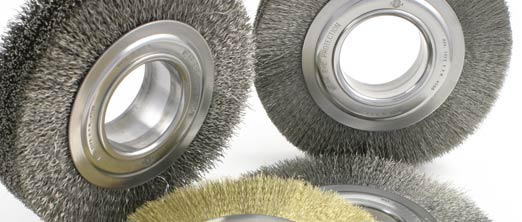Power brushes
are used to remove burrs, scale, dirt, paint, weld slag, and other residue. During normal surface finishing operations, power
brushing causes these materials to fly-off with consideration force. In
addition, brush filaments may break because of fatigue. For both the brush tool
operator and nearby personnel, these flying fragments can cause serious injury.
To help power brush users and their co-workers stay safe,
Brush Research Manufacturing (BRM) offers a free Power Brush Safety Guide.
This one-page resource summarizes power brush safety requirements, recommends proper
usage techniques, and provides safety instructions for using BRM’s Flex-Hone® tool and
twisted-in-wire brushes.
Power
Brush Safety Requirements During power brushing operations, both the
operator and nearby personnel should wear either safety goggles or full face
shields over safety glasses with side shields. Keep all machine guards in
place, wear protective clothing, and observe all speed restrictions. The American Brush Manufacturers Association (ABMA)
and the American National Standards Institute
(ANSI) have safety standards for power brushes.
Power
Brush Usage Recommendations Avoid
applying excessive amounts of pressure to power brush filaments. Too much
pressure can cause them to over-bend and heat-up, resulting in filament
breakage, rapid dulling, and reduced power brush life. To avoid unsafe
operating conditions, replace power brushes with worn bearings, bent spindles,
or that are out-of-balance. Never use a failed or worn brush tool.
If the power brush you’re using is functioning properly
but inadequate for your application, choose
a brush tool with a more aggressive cutting action. You can also increase
the number of revolutions per minute (RPM), but never exceed the maximum safe
speed (MSFS). Use common-sense, and follow all applicable safety regulations to
avoid operator injury.
Safety
Instructions for BRM Brush Tools BRM’s
Power Brush Safety Guide also provides safety instructions for our Flex-Hone® tool
and twisted-in-wire
brushes. Before using these
industrial brushes under power, secure them in a collet, chuck, or similar
holding device. When securing the workpiece, ensure that the brush tool will rotate
on the true centerline. To avoid breaking the tool’s shank, avoid excessive
speed and load conditions.
To learn more from the Power Brush Safety Guide, visit this page
on our website, or click
here for a free .pdf version. Check out the Power
Brush Engineering Guide, too. Please let us know if you have questions or
comments about power brushes any of BRM’s industrial brush tools.
No comments:
Post a Comment